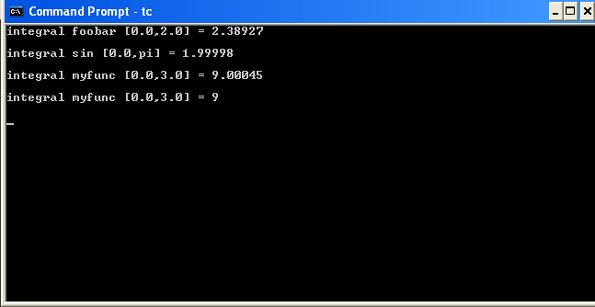The trapezoidal rule is the simplest method to approximate the definite integral of a function f(x) over the interval [a, b]. Given N equally space points (with a spacing of h) X0, X1, …, XN such that X0 = a and XN = b, the integral of f(x) can be approximated as the sum.
(X0/2=X1+X2+……+Xn-1+Xn/2)
The program TRAPEZOID.C integrates a function whose pointer is passed to it using the trapezoidal rule.
#include <stdlib.h>
#include <math.h>
#include <stdio.h>
/* function prototypes */
double integrate(double(*func)(double),
double xa, double xb, int intervals);
double foobar(double x);
double myfunc(double x);
double foobar(double x)
{
return (exp(x)-2.0);
}
double myfunc(double x)
{
return x*x;
}
double integrate(double(*yfunc)(double),
double xa, double xb, int nintervals)
{
double sum=0.0, x, hwidth;
int iter;
x = xa;
hwidth = (xb-xa)/nintervals;
for(iter=0;iter<nintervals-1;iter++)
{
x+= hwidth;
sum+= yfunc(x);
}
sum+= yfunc(xa)/2.0;
sum+= yfunc(xb)/2.0;
return sum*hwidth;
}
int main()
{
double integral, pi;
clrscr();
integral=integrate(foobar,0.0,2.0,100);
printf("integral foobar [0.0,2.0] = %lg\n\n",integral);
pi = acos(-1.0) ;
integral=integrate(sin,0.0,pi ,300);
printf("integral sin [0.0,pi] = %lg\n\n",integral);
integral=integrate(myfunc,0.0,3.0,100);
printf("integral myfunc [0.0,3.0] = %lg\n\n",integral);
integral=integrate(myfunc,0.0,3.0,1000);
printf("integral myfunc [0.0,3.0] = %lg\n\n",integral);
return 0;
getch();
}

 Dinesh Thakur holds an B.C.A, MCDBA, MCSD certifications. Dinesh authors the hugely popular
Dinesh Thakur holds an B.C.A, MCDBA, MCSD certifications. Dinesh authors the hugely popular